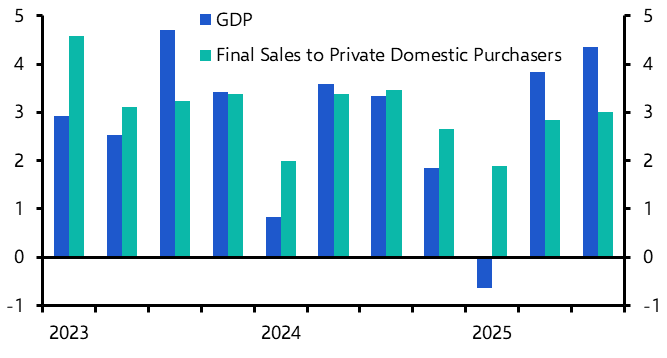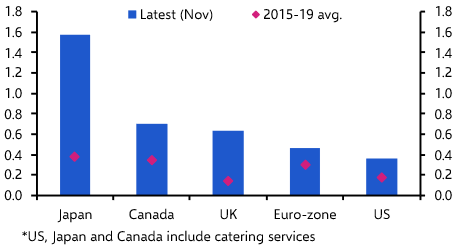Our new indicators compare how successfully economies are shaking off the coronavirus impact
Two of the questions we are asked most frequently by clients are: why has the pandemic caused more economic damage in some countries than it has others? And how should we track the extent of the recovery over the coming weeks and months?
As with most questions that have followed in the wake of the virus, it is difficult to come up with firm answers. In economics, at least, a lot of this uncertainty stems from limitations in the available data. The hard activity data on things like retail sales, industrial production and ultimately GDP provide the most complete picture of output and activity but come with a long delay. Meanwhile, the high-frequency data on things like mapping requests and electricity consumption are available in real-time but provide only a snapshot of conditions in a narrow subset of sectors.
Despite these challenges, however, it’s possible to shed light on both of these important questions.
Even accounting for data problems, the variation in the extent of the economic damage inflicted by the virus on different countries is striking. Of course, output everywhere has been hit extremely hard over the past few months. But our estimates of the scale of the peak-to-trough fall in real GDP, based on everything from high-frequency data to business surveys, range from 8% in Sweden to 25-30% in Italy, France and the UK. Germany and the US sit somewhere in the middle of the pack. (See Chart 1.)
Chart 1: CE Forecast Peak to Trough Change in GDP (%, Q4 2019 – Q2 2020)
 Source: Capital Economics
Source: Capital Economics
Two factors appear to explain the wide range of different outcomes. The first is the sectoral make-up of individual economies. Some sectors, including tourism, car production and consumer-facing services such as leisure and retail, have been hit hard by lockdowns. But others, including IT, financial services and food and pharmaceutical production, have fared much better. It follows that countries that are more dependent on the former group of industries (and less dependent on the latter) have experienced larger falls in output.
The second, more important, factor that explains the difference in outcomes has been the severity of the lockdowns that were imposed to bring the virus under control. Sweden’s light-touch lockdown has been the subject of much debate and its effectiveness in terms of tackling the spread of the virus is unlikely to become clear for many months, if not years. But, so far at least, it does seem that its economy has suffered less as a result.
In contrast, those countries that imposed more stringent lockdowns, including France, Italy, Spain and the UK, appear to have experienced much larger falls in output.
The true extent of the contraction in output will become clearer as the hard activity data for April and May are released over the next month or so. This will enable us to firm up our estimates of the peak-to-trough falls in GDP. However, while a large dispersion in the range of outcomes for different countries looks inevitable, the good news, as I noted a couple of weeks ago, is that most economies now appear to have bottomed out.
This brings us to the question of how we should track the recovery – and it gets to the heart of the debate over the usefulness of high-frequency data. The current downturn is unique in many respects, but one is that it is the first we have been able to track in real time. It is now commonplace to cite data on everything from traffic congestion to port arrivals. However, it is important to understand what these data do and don’t tell us.
They are clearly narrow in their coverage and fail to capture activity in key sectors. What’s more, they tell us almost nothing about the state of demand, which will be critical to determining the scale and speed of the economic recovery. More car journeys do not necessarily translate into more consumer spending. On top of all that, there are inconsistencies in the coverage of these high-frequency data between countries.
But despite all of this they can play an important role in identifying trends and turning points ahead of the official data. To help clients navigate the path out of the crisis, we have developed a series of “Covid-19 Recovery Trackers”. These use real-time data to track activity on a consistent basis in major economies. (Read more here.) They don’t tell us anything about the precise pace of GDP growth or the performance of individual sectors. But they do allow us to identify the direction of travel - including whether recoveries are stalling. (See Charts 2 & 3.)
Chart 2: Covid-19 Recovery Tracker for Selected DMs (% change in activity from pre-virus levels)
 Sources: Google, Apple, Moovit, Oxford University, Capital Economics
Sources: Google, Apple, Moovit, Oxford University, Capital Economics
Chart 3: Covid-19 Recovery Tracker for Selected EMs (% change in activity from pre-virus levels)
 Sources: Google, Apple, Moovit, Oxford University, Capital Economics
Sources: Google, Apple, Moovit, Oxford University, Capital Economics
As things stand, two points stand out. The first is that all major economies now seem to be finding their feet. But the second is that there appears to be significant variation in the extent to which economic conditions are improving in different countries. This seems to be related to the success in stemming the spread of the virus and the subsequent speed at which lockdown restrictions have been eased. So while conditions in parts of Asia, including Taiwan, are now close to normal levels, countries that have struggled to contain the virus or have been slower to lift restrictions, including Brazil, India and the UK, are lagging behind. We’ll update our Recovery Trackers on a weekly basis on our coronavirus page and will have more to say on the recovery as it unfolds.
In case you missed it:
- Our Asia team takes stock of the latest data from China and India. In the case of China, there is evidence that the economy may no longer be contracting in year-on-year terms.
- Our Senior Economic Adviser, Vicky Redwood, looks at how different countries are likely to address the fiscal costs of the crisis.
- Our Senior Markets Economist, Oliver Jones, argues that despite the sharp pullback over the past few days, the rally in risky assets may have further to run.



